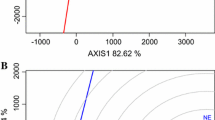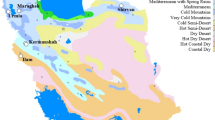Abstract
Although plant breeding programs can vary in operations and objectives, all must contain high performing germplasm and diverse testing environments. Additionally, these elements must be well understood in order for the program to be successful. The purpose of this research was to investigate Texas A&M (TAM) hard red winter wheat variety trial locations and germplasm. The objective of this study was to gain a better understanding of the environments and germplasm by utilizing yield data from 2008 to 2012 advanced variety trials and biplot analysis. Results revealed high significant differences (P < 0.0001) amongst environments, varieties, and variety-by-environment interaction. Three mega-environments within Texas were identified as the High Plains, Rolling Plains, and Blacklands/South Texas and several environments were found to produce high yields each year. ‘Duster’ (PI 639233) was found to be the highest yielding and most stable variety across environments, in this limited set of varieties; while ‘TAMW-101’ (CItr 15324) was the lowest yielding and unstable.




Similar content being viewed by others
References
Abdalla OS, Crossa J, Cornelius PL (1997) Results and biological interpretation of shifted multiplicative model clustering of durum wheat cultivars and test site. Crop Sci 37:88–97
Abou-El-Fittough HA, Rawlings JO, Miller PA (1969) Classification of environments to control genotype by environment interactions with an application to cotton. Crop Sci 9:135–140
Byth DE, Eisemann RL, De Lacy IH (1976) Two-way pattern analysis of a large data set to evaluate genotypic adaptation. Heredity 37:215–230
Carver BF, Smith EL, Hunger RM, Klatt AR, Edwards JT, Porter DR, Verchot-Lubicz J, Rayas-Duarte P, Bai G-H, Martin BC, Krenzer EG, Seabourn BW (2006) Registration of ‘Endurance’ wheat. Crop Sci 46:1816–1817
Edwards JT, Hunger RM, Smith EL, Horn GW, Chen MS, Yan L, Bai G, Bowden RL, Klatt AR, Rayas-Duarte P, Osburn RD, Giles KL, Kolmer JA, Jin Y, Porter DR, Seabourn BW, Bayles MB, Carver BF (2012) ‘Duster’ wheat: a durable, dual-purpose cultivar adapted to the southern great plains of the USA. J Plant Reg 6:37–48
Gabriel KR (1971) The biplot graphic display of matrices with application to principle component analysis. Biometrika 58:453–467
Gauch HG, Zobel RW (1997) Identifying mega-environments and targeting genotypes. Crop Sci 37:311–326
Ghaderi A, Everson EH, Cress CE (1980) Classification of environments and genotypes in wheat. Crop Sci 20:707–710
Guitard AA (1960) The use of diallel correlations for determining the relative locational performance of varieties of barley. Can J Plant Sci 40:645–651
Horner TW, Frey KJ (1957) Methods for determining natural areas for oat varietal recommendations. Agron J 49:313–315
Karimizadeh R, Mohammadi M, Sabaghni N, Mahmoodi A, Roustami B, Seyyedi F, Akbari F (2013) GGE biplot analysis of yield stability in multi-environment trials of lentil genotypes under rainfed condition. Not Sci Biol 5(2):256–262
Lazar MD, Worrall WD, Peterson GL, Fritz AK, Marshall D, Nelson LR, Rooney LW (2004) Registration of ‘TAM 111’ wheat. Crop Sci 44:355–356
Malla S, Ibrahim A, Little R, Kalsbeck S, Glover K, Ren C (2010) Comparison of shifted multiplicative model, rank correlation, and biplot analysis for clustering winter wheat production environments. Euphytica 174:357–370
Microsoft Corporation (2013) Microsoft Office 2013. Redmond, Washington. Available at: https://www.microsoft.com/en-us/. Accessed 4 Apr 2018
Mohammadi R, Armion M, Sadeghzadeh D, Amri A, Nachit M (2011) Analysis of genotype-by-environment interaction for agronomic traits of durum wheat in Iran. Plant Prod Sci 14:15–21
Munaro L, Genin G, Marchioro V, Franco F, Silva R, Silva C, Beche E (2014) Brazilian spring wheat homogeneous adaption regions can be dissected in major megaenvironments. Crop Sci 54:1374–1383
Oklahoma Foundation Seed Stocks (2010) Duster hard red winter wheat. Available at: http://www.okgenetics.com/files/Duster%20Brochurefeb%202014.pdf. Accessed 6 Oct 2015
Porter KB (1974) Registration of TAM W-101 wheat. Crop Sci 14:608
Rudd JC, Devkota RN, Fritz AK, Baker JA, Obert DE, Worrall D, Sutton R, Rooney LW, Nelson LR, Weng Y, Morgan GD, Bean B, Ibrahim AM, Klatt AR, Bowden RL, Graybosch RA, Jin Y, Seabourn BW (2011a) Registration of ‘TAM 401’ wheat. J Plant Reg 6:60–65
Rudd JC, Devkota RN, Baker JA, Ibrahim AM, Worrall D, Lazar MD, Sutton R, Rooney LW, Nelson LR, Bean B, Duncan R, Seabourn BW, Bowden RL, Jin Y, Graybosch RA (2011b) Registration of ‘TAM 113’ wheat. J Plant Reg 7:63–68
Rudd JC, Devkota RN, Baker JA, Peterson GL, Lazar MD, Bean B, Worrall D, Baughman T, Marshall D, Sutton R, Rooney LW, Nelson LR, Fritz AK, Weng Y, Morgan GD, Seabourn BW (2014) ‘TAM 112’ wheat, resistant to greenbug and Wheat Curl Mite and adapted to the dryland production system in the Southern High Plains. J Plant Reg 8:291–297
Rudd JC, Devkota RN, Ibrahim AM, Marshall D, Sutton R, Baker JA, Peterson GL, Herrington R, Rooney LW, Nelson LR, Morgan GD, Fritz AK, Erickson CA, Seabourn BW (2015) ‘TAM 304’ wheat, adapted to the adequate rainfall or high-input irrigated production system in the Southern Great Plains. J Plant Reg 9:331–337
SAS Institue Inc. (2013) SAS Software Version 9.4. Cary, North Carolina. Available at: https://www.sas.com/en_us/home.html. Accessed 4 Apr 2018
Sears RG, Moffatt JM, Martin TJ, Cox TS, Bequette RK, Curran SP, Chung OK, Heer WF, Long JH, Witt MD (1997) registration of ‘Jagger’ wheat. Crop Sci 37:1010
United States Department of Agriculture- Economic Research Service (2015) Wheat data overview. Available at: http://www.ers.usda.gov/data-products/wheat-data.aspx. Accessed 21 Sept 2015
Watson S (2009) Wheat varieties for Kansas and the Great Plains, 2010: your best choices. Lone Tree Publishing, Topeka
Wintersteiger AG (2018) Ried im Innkreis, Austria. Available at: https://www.wintersteiger.com/us/Home. Accessed 24 May 2018
Yan W (2001) GGE biplot-a windows application for graphical analysis of multi-environment trial data and other types of two way data. Agron J 93:1111–1118
Yan W, Hunt LA (2002) Biplot analysis of multi-environment trial data. In: Kang MS (ed) Quantitative genetics, genomics, and plant breeding. CABI Pub, Wallingford, New York
Yan W, Tinker N (2006) Biplot analysis of multi-environment trial data: principles and applications. Can J Plant Sci 86:623–645
Yan W, Hunt LA, Sheng Q, Szlavnics Z (2000) Cultivar evaluation and mega-environment investigation based on the GGE biplot. Crop Sci 40:597–605
Acknowledgements
We thank all of the members of the Texas A&M AgriLife Research and Extension Small Grains program who provided assistance in planting, growing, and harvesting these research plots across the state. We would also like to thank the Texas Wheat Producers Board for providing the funding to conduct the UVT trials.
Author information
Authors and Affiliations
Corresponding author
Additional information
Publisher's Note
Springer Nature remains neutral with regard to jurisdictional claims in published maps and institutional affiliations.
Rights and permissions
About this article
Cite this article
Gerrish, B.J., Ibrahim, A.M.H., Rudd, J.C. et al. Identifying mega-environments for hard red winter wheat (Triticum aestivum L.) production in Texas. Euphytica 215, 129 (2019). https://doi.org/10.1007/s10681-019-2448-8
Received:
Accepted:
Published:
DOI: https://doi.org/10.1007/s10681-019-2448-8




